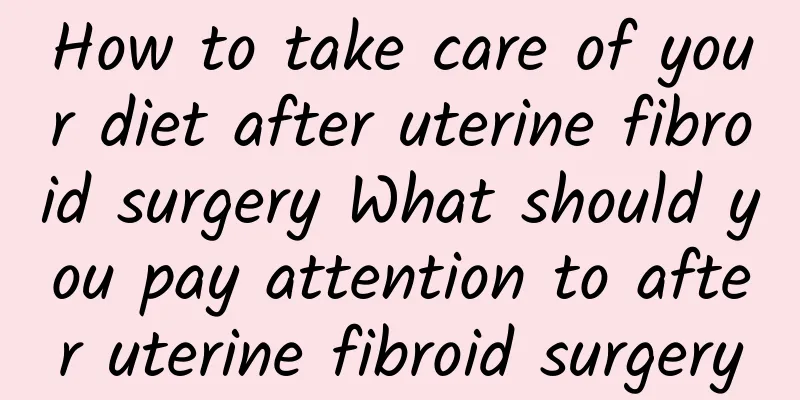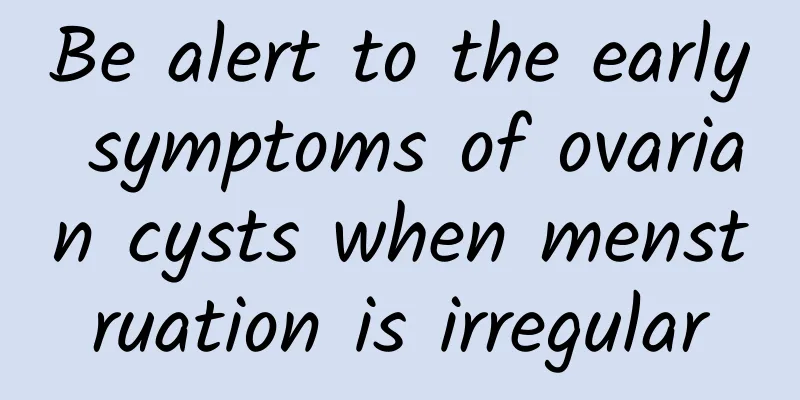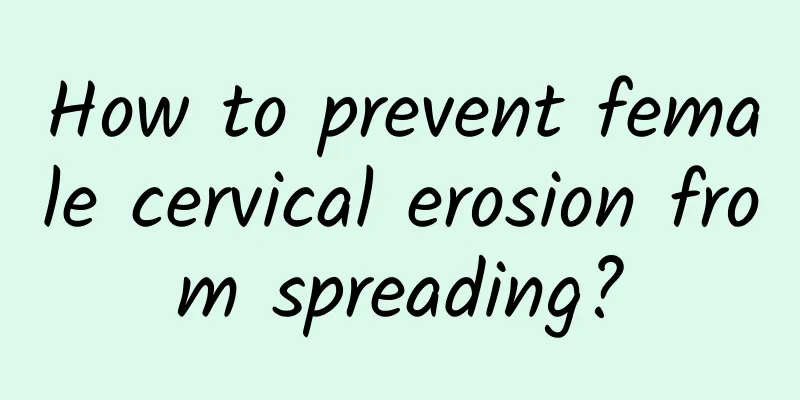How to take care of your diet after uterine fibroid surgery What should you pay attention to after uterine fibroid surgery

|
The main things to note after minimally invasive surgery for uterine fibroids are: 1. Carefully take care of the surgical wound: After uterine fibroid surgery, the patient's surgical wound is usually at the navel, about 1 cm long. Keep the wound clean and dry after surgery, and do not scratch the wound at will. The wound usually heals ten days after surgery. During this period, avoid getting the wound wet by showering. 2. Develop regular daily living habits: After uterine fibroid surgery, patients need to get enough rest and eat a light diet to help with recovery. If the recovery is good, patients can resume their normal work and rest routine within 7 days after surgery. Patients who like to stay up late and have irregular work and rest routines should be strict with themselves after surgery and develop a healthy and reasonable work and rest schedule for themselves. 3. Moderate exercise: Usually patients recover well 50 days after uterine fibroid surgery. According to their physical condition, they can choose the right exercise for themselves and persist in exercising to help improve their physical fitness. The diet after minimally invasive surgery for uterine fibroids should also be taken care of. For example, patients with uterine fibroids should eat light meals and it is best not to eat mutton, dog meat, shrimp, crab, eel, salted fish, black fish and other hair-raising foods. Patients with uterine fibroids can eat more seaweed foods, such as laver, kelp, cabbage, wakame, etc. Seaweed contains the most minerals such as calcium, iron, sodium, magnesium, phosphorus, and iodine. Modern science believes that eating seaweed foods regularly can effectively regulate blood pH and prevent excessive consumption of alkaline elements (calcium and zinc) in the body due to acid neutralization. Maintain a low-fat diet and eat more lean meat, chicken, eggs, quail eggs, crucian carp, turtle, white fish, cabbage, asparagus, celery, spinach, cucumber, winter melon, mushrooms, tofu, kelp, seaweed, fruits and other cool vegetables and fruits. What kind of diet should be taken after minimally invasive surgery for uterine fibroids? Which foods are more suitable for recovery? Patients with uterine fibroids should eat light meals and it is best not to eat irritating foods such as mutton, dog meat, shrimp, crab, eel, salted fish, and black fish. 2. Patients with uterine fibroids should eat more whole grains such as corn and beans, and can also eat some nutritious dried fruits such as peanuts, sesame seeds, melon seeds, etc. In addition, daily tea and rice should be quantified on time to prevent overeating. 3. Eat more lean meat, chicken, eggs, quail eggs, crucian carp, turtle, white fish, cabbage, asparagus, celery, spinach, cucumber, winter melon, mushrooms, tofu, kelp, seaweed, fruits and other cold dishes and fruits. 4. Patients with uterine fibroids can eat more seaweed foods, such as laver, kelp, cabbage, wakame vegetables, etc. Seaweed contains the most minerals such as calcium, iron, sodium, magnesium, phosphorus, iodine, etc. Modern science believes that regular consumption of seaweed foods can effectively regulate blood pH and avoid excessive consumption of alkaline elements (calcium and zinc) in the body due to acid neutralization. How long you need to rest after uterine fibroid surgery varies. Because traditional uterine fibroid surgery is harmful to women's bodies, you need to rest for a long time after surgery to recover. Traditional uterine fibroid surgery requires at least two weeks of rest. Full recovery takes two to three months. For patients who choose minimally invasive surgery to treat uterine fibroids, they usually stay in the hospital for 2-3 days, rest for 1-2 weeks, and fully recover in about 1-2 months. The specific rest method after uterine fibroid surgery is related to the patient's physical condition. |
Recommend
Can I have sex if there is brown discharge on my underwear during my non-menstrual period?
If brown discharge appears on your underwear duri...
What can you eat to induce a miscarriage? Don’t eat these 7 common foods
Pregnant women have many food taboos during pregn...
What is the cause of premature ovarian failure?
What are the causes of premature ovarian failure?...
Are there any side effects of abortion?
Are there any side effects of abortion? Abortion ...
Why does vaginal candidiasis recur?
Why does candidal vaginitis recur? The recurrence...
How to treat endometrial thickening best
Thick endometrium may be caused by many reasons, ...
Prevent chest expansion! 3 moves to shape firm and beautiful breasts
By bringing the shoulder blades closer together, ...
Experts explain what painless abortion is like
Painless abortion is very popular now, but not ev...
Women should undergo pre-abortion examinations in advance
Modern people's minds are open, resulting in ...
What to do if the first child has a miscarriage? Be sure to pay attention to these 5 points
Every woman hopes to have a smooth pregnancy and ...
Causes of irregular menstruation in women
What are the causes of irregular menstruation in ...
What are the methods for checking congenital absence of vagina?
Congenital absence of vagina is caused by bilater...
Can ectopic pregnancy test strips detect it?
Ectopic pregnancy, which is an abnormal pregnancy...
What should women eat during menopause?
People in menopause often suffer from insomnia an...
What medicine should I take for stomach pain caused by adnexitis?
If you have stomach pain due to adnexitis, it can...









